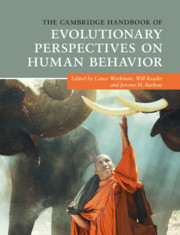Book contents
- The Cambridge Handbook of Evolutionary Perspectives on Human Behavior
- The Cambridge Handbook of Evolutionary Perspectives on Human Behavior
- Copyright page
- Dedication
- Contents
- Figures
- Tables
- Contributors
- Preface
- Acknowledgments
- Part I The Comparative Approach
- Part II Sociocultural Anthropology and Evolution
- Part III Evolution and Neuroscience
- Part IV Group Living
- Part V Evolution and Cognition
- Part VI Evolution and Development
- Part VII Sexual Selection and Human Sex Differences
- Part VIII Abnormal Behavior and Evolutionary Psychopathology
- Part IX Applying Evolutionary Principles
- 36 A Bridge Too Far?
- 37 The Evolution of Personality
- 38 Applying Evolutionary Principles to Criminality
- 39 Substitute Parenting
- 40 Historians and the Evolutionary Approach to Human Behavior
- 41 The Psychology of Extraterrestrials
- Part X Evolution and the Media
- Index
- References
40 - Historians and the Evolutionary Approach to Human Behavior
from Part IX - Applying Evolutionary Principles
Published online by Cambridge University Press: 02 March 2020
- The Cambridge Handbook of Evolutionary Perspectives on Human Behavior
- The Cambridge Handbook of Evolutionary Perspectives on Human Behavior
- Copyright page
- Dedication
- Contents
- Figures
- Tables
- Contributors
- Preface
- Acknowledgments
- Part I The Comparative Approach
- Part II Sociocultural Anthropology and Evolution
- Part III Evolution and Neuroscience
- Part IV Group Living
- Part V Evolution and Cognition
- Part VI Evolution and Development
- Part VII Sexual Selection and Human Sex Differences
- Part VIII Abnormal Behavior and Evolutionary Psychopathology
- Part IX Applying Evolutionary Principles
- 36 A Bridge Too Far?
- 37 The Evolution of Personality
- 38 Applying Evolutionary Principles to Criminality
- 39 Substitute Parenting
- 40 Historians and the Evolutionary Approach to Human Behavior
- 41 The Psychology of Extraterrestrials
- Part X Evolution and the Media
- Index
- References
Summary
Darwinian approaches to human behavior are inherently historical; recounting the origin and development of Homo sapiens and the increasing complexity of human societies over many millennia is second nature to evolutionary psychologists and behavioral ecologists. Admitting the existence of biologically based human universals entails some considerable adjustment for historians, who are forced to retool by learning more about various social and biological sciences. Most historians have specialized interests by region, period, and topic; it is rare enough for practitioners to study the same problem across longer periods or in a different locale.
This contribution will try to speak to both communities of scholars, on the off chance that practicing historians will wish to rethink their problems afresh from the perspective of human nature. Historians often assume that all of our practices are subject to constant change, where we can apply a date to observable shifts in behavior.
- Type
- Chapter
- Information
- Publisher: Cambridge University PressPrint publication year: 2020



